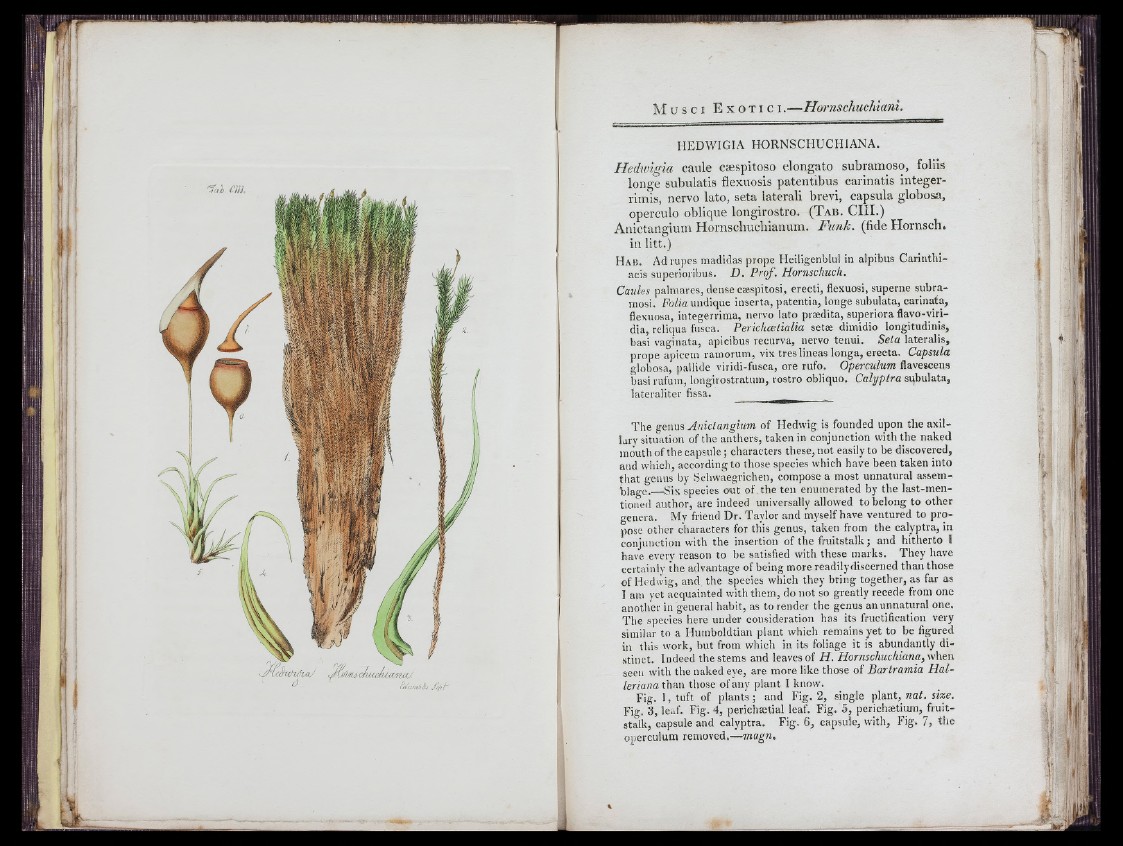
Ii ;7í :
■ : ’
i1 :! I'
\ ^
tem ih jfu x J fw / ii jm u m m .'i iM y .
HEDWIGIA HORNSCHUCHIANA.
Hedwlgia caule cajspitoso elongato subramoso, foliis
longe subulatis ñexuosis patentibus carinatis integerrimis,
nervo lato, seta laterali brevi, capsula globosa,
operculo oblique longirostro. ( T a b . CIÍI.)
Anictangiuni Hornschuchianum. Fimk. (fide Hornsch.
in litt.)
H ad. Ad ñipes madidas prope Heiligenblul in alpibus Carintbi-
acis superioribus. D . Prof. Hornschuch.
Caules palmares, dense csespitosi, erecti, flexuosi, superne subramosi.
Folia undique inserta, patentia, longe subulata, carinata,
flexuosa, integerrima, nervo lato praedita, superiora flavo-yiri-
dia, reliqua fusca. Perichcetialia setae dimidio longitudinis,
basi vag'inata, apicibus recurva, nervo tenui. Seta lateralis,
prope apicem ramorum, vix tres lineas longa, erecta. Capsula
globosa, pallide viridi-fusca, ore rufo. Operculum flavescens
basi rufum, longirostratum, rostro obliquo. Calyptra subulata,
lateraliter fissa. _________________
The genus Anictangium of Hedwig is founded upon the axillary
situation of the anthers, taken in conjunction with the naked
mouth of the capsule ; characters these, not easily to be discovered,
and which, according to those species which have been taken into
that genus by Schwaegrichen, compose a most unnatural assemblage.—
Six species out of the ten enumerated by the last-mentioned
author, are indeed universally allowed to belong to other
genera. My friend Dr. Taylor and myself have ventured to propose
other characters for this genus, taken from the calyptra, in
conjunction with the insertion of the fruitstalk ; and hitherto I
have every reason to be satisfied with these marks. They have
certainly the advantage of being more readilydiscerned than those
of Hedwig, and the species which they bring together, as far as
1 am yet acquainted with them, do not so greatly recede from one
another in general habit, as to render the genus an unnatural one.
The species here under consideration has its fructification very
similar to a Humboldtian plant which remains yet to be figured
in this work, but from which in its foliage it is abundantly distinct.
Indeed the stems and leaves of H . Hornschuchiana, when
seen with the naked eye, are more like those of Bartramia Hal-
leriaaa than tliose of any plant I know.
Fig. 1, tuft of plants ; and Fig. 2, single plant, nat. size.
Fig. 3, leaf. Fig. 4, perichmtial leaf. Fig. 5, perichaetiimqjruit-
stalk, capsule and calyptra. Fig. 6, capsule, with, Fig. 7, tbe
operculum removed.—magn.
* ,
i. j|
ii' y
; i3 ' M
y : ‘i -
LY'